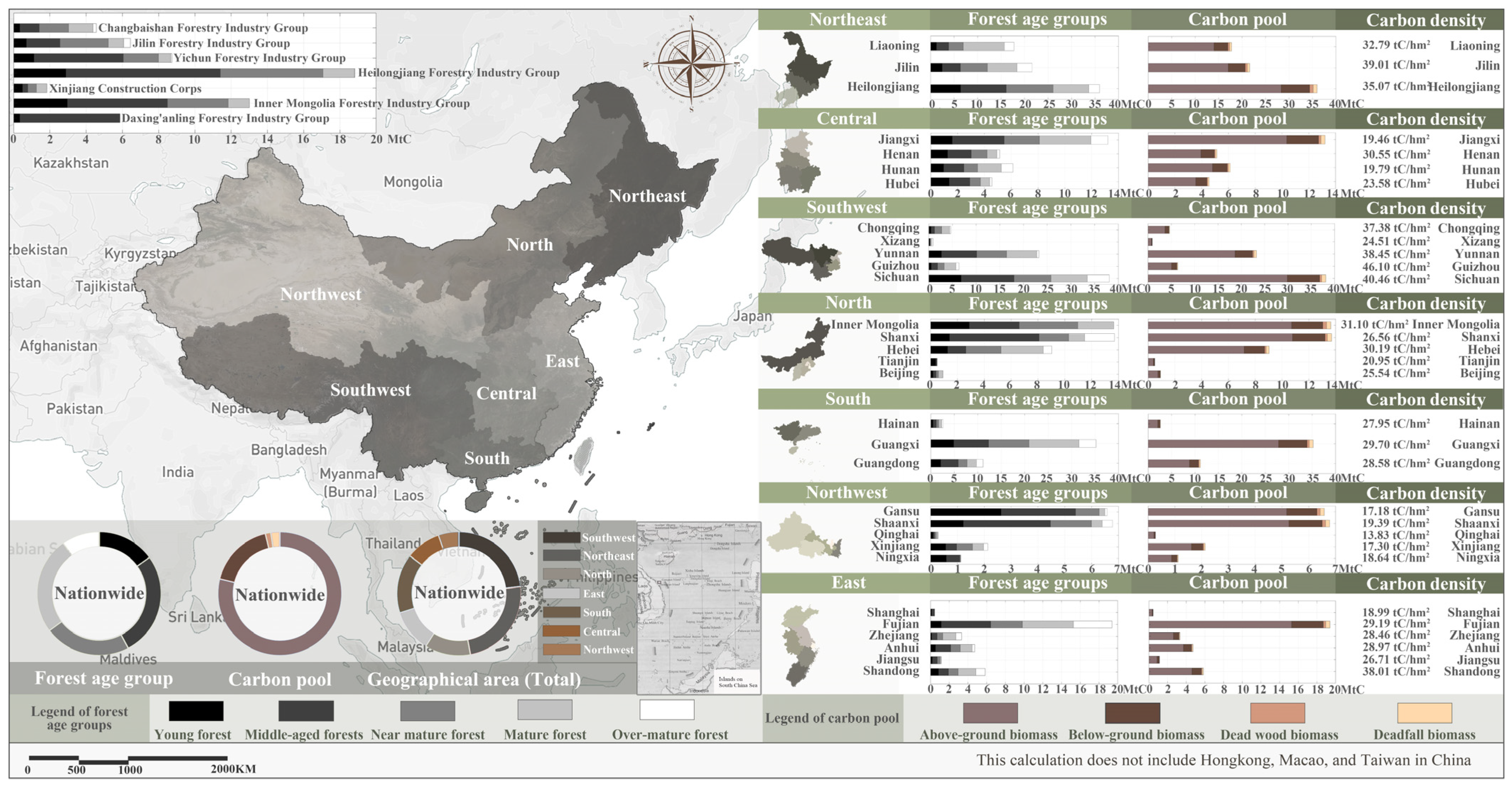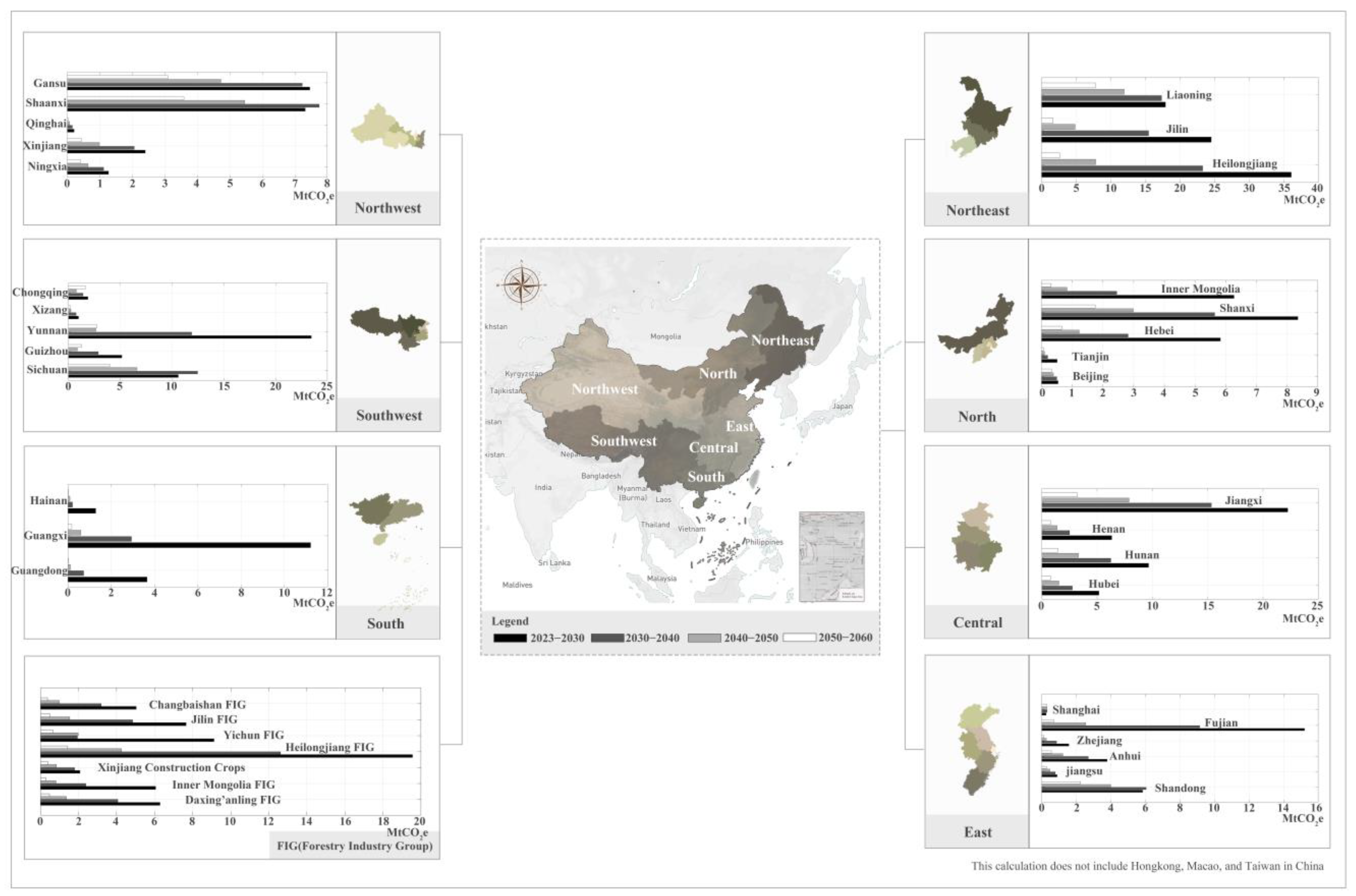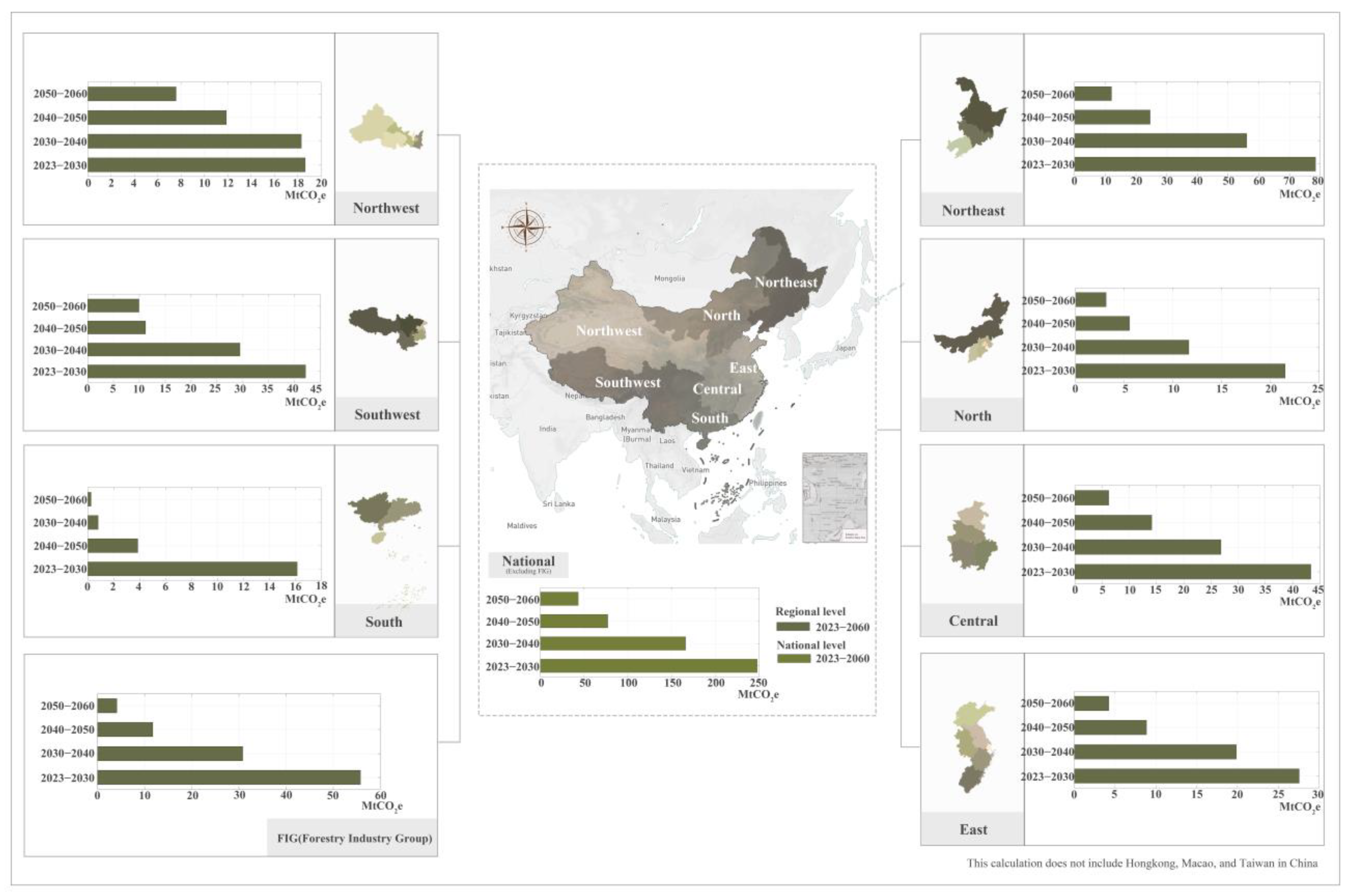Assessing Carbon Sequestration Potential in State-Owned Plantation Forests in China and Exploring Feasibility for Carbon Offset Projects
Abstract
1. Introduction
2. Materials and Methods
2.1. Study Area
2.2. Above-Ground Biomass Carbon Pool
2.3. Below-Ground Biomass Carbon Pool
2.4. Dead Wood Biomass Carbon Pool
2.5. Deadfall Biomass Carbon Pool
2.6. Carbon Sequestration Potential of State-Owned Plantation Forests
2.6.1. Forest Carbon Stock Prediction
2.6.2. Forest Carbon Mitigation
2.7. Carbon Density
2.8. Data Sources and Analysis
2.9. Scenario Settings
3. Results
3.1. Carbon Stock and Carbon Density
3.2. Prediction of Carbon Stock and Carbon Density
3.3. Prediction of Carbon Sink
3.4. Bias Analysis
4. Discussion
4.1. Analysis of the Carbon Offsetting Capacity of State-Owned Forest
4.2. New Pathways for Expanding the Potential of Carbon Offsetting Mechanisms in China’s Forests—Developing Methodologies for Natural Forests
4.3. Development Strategy for Forestry Carbon Offset Programs in China
4.3.1. Extending the Application Conditions of the Methodologies
4.3.2. Active Development of the Carbon Inclusion Mechanism
5. Conclusions
Supplementary Materials
Author Contributions
Funding
Data Availability Statement
Conflicts of Interest
References
- Van Der Gaast, W.; Sikkema, R.; Vohrer, M. The contribution of forest carbon credit projects to addressing the climate change challenge. Clim. Policy 2018, 18, 42–48. [Google Scholar] [CrossRef]
- Austin, K.G.; Baker, J.S.; Sohngen, B.L.; Wade, C.M.; Daigneault, A.; Ohrel, S.B.; Ragnauth, S.; Bean, A. The economic costs of planting, preserving, and managing the world’s forests to mitigate climate change. Nat. Commun. 2020, 11, 5946. [Google Scholar] [CrossRef] [PubMed]
- Rossi, D.J.; Baker, J.S.; Abt, R.C. Quantifying additionality thresholds for forest carbon offsets in Mississippi pine pulpwood markets. For. Policy Econ. 2023, 156, 103059. [Google Scholar] [CrossRef]
- Broekhoff, D.; Gillenwater, M.; Colbert-Sangree, T.; Cage, P. Securing Climate Benefit: A Guide to Using Carbon Offsets; Stockholm Environment Institute & Greenhouse Gas Management Institute: 2019. Available online: https://www.offsetguide.org/pdf-download/ (accessed on 16 May 2024).
- Ecosystem Marketplace. 2022. Available online: https://data.ecosystemmarketplace.com/ (accessed on 20 September 2023).
- Hu, M. United Nations Framework Convention on Climate Change (UNFCCC). 2021. Available online: https://climatechampions.unfccc.int/chinas-net-zero-future/ (accessed on 20 September 2023).
- United Nations Framework Convention on Climate Change (UNFCCC). 2021. Available online: https://www4.unfccc.int/sites/NDCStaging/pages/Party.aspx?party=CHN (accessed on 20 September 2023).
- Zhu, Y.; Lan, H.; Ness, D.A.; Xing, K.; Schneider, K.; Lee, S.H.; Ge, J.; Zhu, Y.; Lan, H.; Ness, D.A.; et al. Carbon trade, forestry land rights, and farmers’ livelihood in rural communities in China. In Transforming Rural Communities in China and Beyond: Community Entrepreneurship and Enterprises, Infrastructure Development and Investment Modes; Springer: Cham, Switzerland, 2015; pp. 61–91. [Google Scholar]
- Ministry of Ecology and Environment of the People’s Republic of China. Notice on the Issuance of Four Methodologies, including the Methodology for Greenhouse Gas Voluntary Emission Reduction Projects Afforestation Carbon Sinks (CCER-14-001-V01). 2023. Available online: https://www.mee.gov.cn/xxgk2018/xxgk/xxgk06/202310/t20231024_1043877.html (accessed on 15 November 2023).
- Sharp, D.D.; Lieth, H.; Whigham, D. Assessment of regional productivity in North Carolina. Prim. Product. Biosph. 1975, 14, 131–146. [Google Scholar] [CrossRef]
- Brown, S.A.; Lugo, A.E. Aboveground biomass estimates for tropical moist forests of the Brazilian Amazon. Interciencia Caracas 1992, 17, 8–18. [Google Scholar]
- Turner, D.P.; Koerper, G.J.; Harmon, M.E.; Lee, J.J. A carbon budget for forests of the conterminous United States. Ecol. Appl. 1995, 5, 421–436. [Google Scholar] [CrossRef]
- Fang, J.Y.; Wang, G.G.; Liu, G.H.; Xu, S.L. Forest biomass of China: An estimate based on the biomass–volume relationship. Ecol. Appl. 1998, 8, 1084–1091. [Google Scholar]
- Fang, J.; Chen, A.; Peng, C.; Zhao, S.; Ci, L. Changes in forest biomass carbon storage in China between 1949 and 1998. Science 2001, 292, 2320–2322. [Google Scholar] [CrossRef]
- Brown, S.L.; Schroeder, P.E. Spatial patterns of aboveground production and mortality of woody biomass for eastern US forests. Ecol. Appl. 1999, 9, 968–980. [Google Scholar] [CrossRef]
- Nilsson, S.; Shvidenko, A.; Stolbovoi, V.; Gluck, M.; Jonas, M.; Obersteiner, M. Full Carbon Account for Russia: Interim Report IR-00-021; International Institute for Applied Systems Analysis: Laxenburg, Austria, 2000. [Google Scholar]
- Fang, J.Y.; Wang, Z.M. Forest biomass estimation at regional and global levels, with special reference to China’s forest biomass. Ecol. Res. 2001, 16, 587–592. [Google Scholar] [CrossRef]
- Guo, Z.; Fang, J.; Pan, Y.; Birdsey, R. Inventory-based estimates of forest biomass carbon stocks in China: A comparison of three methods. For. Ecol. Manag. 2010, 259, 1225–1231. [Google Scholar] [CrossRef]
- Xu, B.; Guo, Z.; Piao, S.; Fang, J. Biomass carbon stocks in China’s forests between 2000 and 2050: A prediction based on forest biomass-age relationships. Sci. China Life Sci. 2010, 53, 776–783. [Google Scholar] [CrossRef]
- He, N.; Wen, D.; Zhu, J.; Tang, X.; Xu, L.; Zhang, L.; Hu, H.; Huang, M.; Yu, G. Vegetation carbon sequestration in Chinese forests from 2010 to 2050. Glob. Chang. Biol. 2017, 23, 1575–1584. [Google Scholar] [CrossRef]
- Qiu, Z.; Feng, Z.; Song, Y.; Li, M.; Zhang, P. Carbon sequestration potential of forest vegetation in China from 2003 to 2050: Predicting Forest vegetation growth based on climate and the environment. J. Clean. Prod. 2020, 252, 119715. [Google Scholar] [CrossRef]
- Kumar, L.; Mutanga, O. Remote Sensing of Above-Ground Biomass. Remote Sens. 2017, 9, 935. [Google Scholar] [CrossRef]
- Penman, J.; Gytarsky, M.; Hiraishi, T.; Krug, T.; Kruger, D.; Pipatti, R.; Buendia, L.; Miwa, K.; Ngara, T.; Tanabe, K.; et al. Good Practice Guidance for Land Use, Land-Use Change and Forestry. 2003. Available online: https://www.ipcc-nggip.iges.or.jp/public/gpglulucf/gpglulucf_files/GPG_LULUCF_FULL.pdf (accessed on 24 September 2023).
- National Forestry and Grassland Administration. China Forest Resources Report; China Forestry Press: Beijing, China, 2019. [Google Scholar]
- National Forest Resources Intelligent Management Platform. 2022. Available online: http://www.stgz.org.cn/ (accessed on 25 September 2023).
- GB/T 38590-2020; Technical Regulations for Continuous Forest Inventory. China Quality Inspection Press: Beijing, China, 2020.
- Feng, Y.; Schmid, B.; Loreau, M.; Forrester, D.I.; Fei, S.; Zhu, J.; Tang, Z.; Zhu, J.; Hong, P.; Ji, C.; et al. Multispecies forest plantations outyield monocultures across a broad range of conditions. Science 2022, 376, 865–868. [Google Scholar] [CrossRef]
- Tong, X.; Brandt, M.; Yue, Y.; Ciais, P.; Rudbeck Jepsen, M.; Penuelas, J.; Wigneron, J.-P.; Xiao, X.-P.; Song, X.-P.; Horion, S.; et al. Forest management in southern China generates short term extensive carbon sequestration. Nat. Commun. 2020, 11, 129. [Google Scholar] [CrossRef] [PubMed]
- Ameray, A.; Bergeron, Y.; Valeria, O.; Girona, M.M.; Cavard, X. Forest carbon management: A review of silvicultural practices and management strategies across boreal, temperate and tropical forests. Curr. For. Rep. 2021, 7, 245–266. [Google Scholar] [CrossRef]
- Li, M.; Liu, H.; Geng, G.; Hong, C.; Liu, F.; Song, Y.; Tong, D.; Zheng, B.; Cui, H.; Man, H.; et al. Anthropogenic emission inventories in China: A review. Natl. Sci. Rev. 2017, 4, 834–866. [Google Scholar] [CrossRef]
- Zhang, F.; Xu, N.; Wu, F. Research on China’s CO2 emissions projections from 2020 to 2100 under the shared socioeconomic pathways. Acta Ecol. Sin. 2021, 41, 9691–9704. (In Chinese) [Google Scholar]
- State Forestry Administration of China, National Forest Management Plan. 2016. Available online: https://www.gov.cn/xinwen/2016-07/28/5095504/files/b9ac167edfd748dc8c1a256a784f40d5.pdf (accessed on 10 December 2023).
- China Forestry and Grassland Administration. Deepening the Reform of the Collective Forest Rights. 2023. Available online: https://www.forestry.gov.cn/c/www/zyxx/529388.jhtml (accessed on 9 May 2024).
- Xu, J.; Xie, S.; Han, A.; Rao, R.; Huang, G.; Chen, X.; Hu, J.; Liu, Q.; Yang, X.; Zhang, L. Forest Resources in China—The 9th National Forest Inventory; National Forestry and Grassland Administration: Beijing, China, 2019. [Google Scholar]
- United Nations Framework Convention on Climate Change (UNFCCC). Mexico’s Forest Reference Emission Level Proposal. 2015. Available online: https://redd.unfccc.int/media/frel_mexico_modified.pdf (accessed on 15 November 2023).
- Parker, C.; Mitchell, A.; Trivedi, M.; Mardas, N.; Sosis, K. The Little REDD+ Book. 2009. Available online: https://globalcanopy.org/wp-content/uploads/2020/12/LRB_en.pdf (accessed on 15 November 2023).
- Herold, M.; Verchot, L.; Angelsen, A.; Maniatis, D.; Bauch, S. A stepwise framework for setting REDD+ forest reference emission levels and forest reference levels. CIFOR Brief 2012, 52, 1–8. [Google Scholar]
- Delacote, P.; Le Velly, G.; Simonet, G. Revisiting the location bias and additionality of REDD+ projects: The role of project proponents status and certification. Resour. Energy Econ. 2022, 67, 101277. [Google Scholar] [CrossRef]
- West, T.A.P.; Wunder, S.; Sills, E.O.; Börner, J.; Rifai, S.W.; Neidermeier, A.N.; Frey, G.P.; Kontoleon, A. Action needed to make carbon offsets from forest conservation work for climate change mitigation. Science 2023, 381, 873–877. [Google Scholar] [CrossRef] [PubMed]
- Ministry of Ecology and Environment of the People’s Republic of China. Measures for the Management of Voluntary Greenhouse Gas Emission Reduction Trading (for Trial Implementation). 2023. Available online: https://www.mee.gov.cn/gzk/gz/202310/t20231020_1043695.shtml (accessed on 10 November 2023).
- Wang, Y.; Bai, G.; Shao, G.; Cao, Y. An analysis of potential investment returns and their determinants of poplar plantations in state-owned forest enterprises of China. New For. 2014, 45, 251–264. [Google Scholar] [CrossRef]
- Berzaghi, F.; Cosimano, T.; Fullenkamp, C.; Scanlon, J.; Fon, T.E.; Robson, M.T.; Forbang, J.L.; Chami, R. Value wild animals’ carbon services to fill the biodiversity financing gap. Nat. Clim. Chang. 2022, 12, 598–601. [Google Scholar] [CrossRef]



| Region | Province | 2030 | 2040 | 2050 | 2060 | ||||
|---|---|---|---|---|---|---|---|---|---|
| Carbon Stock | Carbon Density | Carbon Stock | Carbon Density | Carbon Stock | Carbon Density | Carbon Stock | Carbon Density | ||
| Southwest | Sichuan | 40.99 | 43.53 | 44.40 | 47.14 | 46.20 | 49.06 | 47.29 | 50.22 |
| Guizhou | 7.79 | 56.28 | 8.58 | 61.98 | 8.82 | 63.73 | 9.18 | 66.28 | |
| Yunnan | 29.64 | 49.03 | 32.89 | 54.40 | 33.61 | 55.60 | 34.37 | 56.86 | |
| Xizang | 1.17 | 31.82 | 1.38 | 37.40 | 1.45 | 39.26 | 1.50 | 40.65 | |
| Chongqing | 5.14 | 41.54 | 5.53 | 44.66 | 5.74 | 46.39 | 6.20 | 50.05 | |
| Northeast | Heilongjiang | 45.82 | 44.66 | 52.18 | 50.85 | 54.31 | 52.94 | 55.02 | 53.63 |
| Jilin | 28.30 | 51.08 | 32.53 | 58.70 | 33.85 | 61.09 | 34.31 | 61.91 | |
| Liaoning | 22.65 | 41.82 | 27.38 | 50.55 | 30.64 | 56.57 | 32.76 | 60.49 | |
| North | Beijing | 1.07 | 29.63 | 1.21 | 33.37 | 1.32 | 36.29 | 1.41 | 38.76 |
| Tianjin | 0.63 | 26.85 | 0.69 | 29.20 | 0.71 | 30.36 | 0.73 | 31.15 | |
| Hebei | 10.62 | 35.50 | 11.39 | 38.08 | 11.72 | 39.20 | 11.91 | 39.81 | |
| Shanxi | 15.98 | 30.98 | 17.52 | 33.96 | 18.33 | 35.54 | 18.81 | 36.46 | |
| Inner Mongolia | 15.35 | 35.00 | 16.02 | 36.52 | 16.25 | 37.04 | 16.33 | 37.24 | |
| East | Shandong | 7.43 | 48.37 | 9.09 | 59.11 | 10.18 | 66.23 | 10.79 | 70.21 |
| Jiangsu | 1.38 | 32.49 | 1.60 | 37.58 | 1.73 | 40.66 | 1.80 | 42.41 | |
| Anhui | 5.76 | 35.32 | 6.49 | 39.83 | 6.83 | 41.89 | 6.98 | 42.85 | |
| Zhejiang | 3.75 | 32.16 | 3.99 | 34.19 | 4.07 | 34.83 | 4.10 | 35.12 | |
| Fujian | 23.53 | 35.43 | 26.02 | 39.19 | 26.72 | 40.24 | 26.91 | 40.53 | |
| Shanghai | 0.52 | 21.93 | 0.61 | 25.58 | 0.69 | 29.23 | 0.78 | 32.79 | |
| South | Guangdong | 12.15 | 31.14 | 12.35 | 31.64 | 12.38 | 31.73 | 12.39 | 31.76 |
| Guangxi | 46.42 | 39.15 | 47.22 | 39.83 | 47.39 | 39.97 | 47.44 | 40.01 | |
| Hainan | 3.90 | 41.78 | 3.96 | 42.39 | 3.98 | 42.65 | 3.99 | 42.75 | |
| Central | Hubei | 5.97 | 30.86 | 6.72 | 34.76 | 7.14 | 36.96 | 7.36 | 38.06 |
| Hunan | 8.76 | 28.28 | 10.46 | 33.77 | 11.37 | 36.69 | 11.76 | 37.96 | |
| Henan | 6.86 | 40.81 | 7.55 | 44.90 | 7.93 | 47.15 | 8.14 | 48.45 | |
| Jiangxi | 19.27 | 28.39 | 23.45 | 34.55 | 25.60 | 37.72 | 26.48 | 39.01 | |
| Northwest | Ningxia | 1.47 | 24.39 | 1.77 | 29.44 | 1.95 | 32.34 | 2.06 | 34.22 |
| Xinjiang | 2.79 | 22.60 | 3.35 | 27.16 | 3.62 | 29.35 | 3.74 | 30.31 | |
| Qinghai | 0.33 | 16.74 | 0.37 | 18.92 | 0.39 | 19.89 | 0.40 | 20.29 | |
| Shaanxi | 8.77 | 25.09 | 10.89 | 31.13 | 12.37 | 35.39 | 13.35 | 38.19 | |
| Gansu | 8.61 | 22.49 | 10.58 | 27.64 | 11.88 | 31.01 | 12.72 | 33.23 | |
| National | Total | 392.85 | 37.78 | 438.14 | 42.13 | 459.17 | 44.16 | 471.01 | 45.29 |
| State-owned forest farm | Daxing’ Anling Forestry Industry | 7.58 | 42.38 | 8.69 | 48.58 | 9.06 | 50.66 | 9.19 | 51.35 |
| Inner Mongolia Forestry Industry | 14.66 | 34.57 | 15.31 | 36.09 | 15.53 | 36.61 | 15.61 | 36.81 | |
| Xinjiang Construction Crops | 2.40 | 22.37 | 2.89 | 26.94 | 3.12 | 29.12 | 3.23 | 30.09 | |
| Heilongjiang Forestry Industry | 24.16 | 43.46 | 27.60 | 49.66 | 28.76 | 51.74 | 29.15 | 52.43 | |
| Yichun Forestry Industry | 11.22 | 43.33 | 11.75 | 45.42 | 12.29 | 47.50 | 12.47 | 48.19 | |
| Jilin Forestry Industry | 8.53 | 49.20 | 9.85 | 56.82 | 10.27 | 59.21 | 10.41 | 60.03 | |
| Changbaishan Forestry Industry | 5.94 | 52.04 | 6.81 | 59.65 | 7.08 | 62.04 | 7.18 | 62.87 | |
| Total | 74.49 | 41.15 | 82.90 | 45.80 | 86.11 | 47.57 | 87.24 | 48.20 | |
| Type | Year | Carbon Stock | Area | Carbon Density | Data Source |
|---|---|---|---|---|---|
| National plantations | 2021 | 2276.34 MtC | 76.84 Mhm | 29.62 tC/hm2 | [25] |
| State-owned plantations | 2021 * | 425.30 MtC * | 12.20 Mhm | 34.86 tC/hm2 | - |
Disclaimer/Publisher’s Note: The statements, opinions and data contained in all publications are solely those of the individual author(s) and contributor(s) and not of MDPI and/or the editor(s). MDPI and/or the editor(s) disclaim responsibility for any injury to people or property resulting from any ideas, methods, instructions or products referred to in the content. |
© 2024 by the authors. Licensee MDPI, Basel, Switzerland. This article is an open access article distributed under the terms and conditions of the Creative Commons Attribution (CC BY) license (https://creativecommons.org/licenses/by/4.0/).
Share and Cite
Chen, Z.; Dayananda, B.; Du, H.; Zhou, G.; Wang, G. Assessing Carbon Sequestration Potential in State-Owned Plantation Forests in China and Exploring Feasibility for Carbon Offset Projects. Forests 2024, 15, 886. https://doi.org/10.3390/f15050886
Chen Z, Dayananda B, Du H, Zhou G, Wang G. Assessing Carbon Sequestration Potential in State-Owned Plantation Forests in China and Exploring Feasibility for Carbon Offset Projects. Forests. 2024; 15(5):886. https://doi.org/10.3390/f15050886
Chicago/Turabian StyleChen, Zheng, Buddhi Dayananda, Huaqiang Du, Guomo Zhou, and Guangyu Wang. 2024. "Assessing Carbon Sequestration Potential in State-Owned Plantation Forests in China and Exploring Feasibility for Carbon Offset Projects" Forests 15, no. 5: 886. https://doi.org/10.3390/f15050886
APA StyleChen, Z., Dayananda, B., Du, H., Zhou, G., & Wang, G. (2024). Assessing Carbon Sequestration Potential in State-Owned Plantation Forests in China and Exploring Feasibility for Carbon Offset Projects. Forests, 15(5), 886. https://doi.org/10.3390/f15050886







